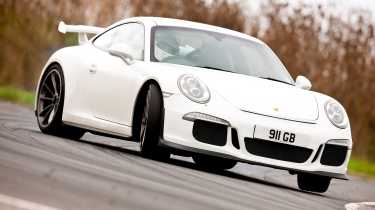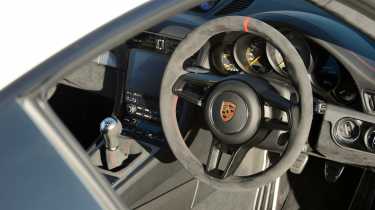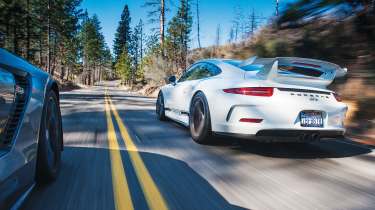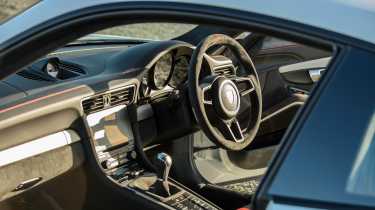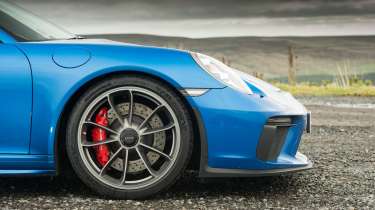Used Porsche 911 GT3 (991, 2013 - 2019) review, specs and buying guide
The 991-generation GT3 brought massive changes for the GT3 bloodline as a whole, for better and worse
As with the Carreras it sat above, the Porsche 911 GT3 got a bit controversial for the 991 generation 911. Revealed at the Geneva Motor Show in 2013, it was larger, heavier, more complicated and shorn of everything from the effervescent Mezger engine to the feelsome manual transmission and hydraulic steering. But it did offer a substantial increase in performance over the 997, to supercar-baiting levels, while the zinging 9000rpm redline and flat-six howl accompaniment was spine-tingling.
Short term pain for the most dedicated enthusiasts turned out to be long-term gain for Porsche, as a market ravenous for analogue hardcore 911s lunged at the eventual re-introduction of the manual. By the time the 991.2 Porsche 911 GT3 arrived, the introduction of the wingless GT3 Touring and the manual gearbox were headline-grabbing sweeteners. But in reality, almost everyone had already warmed to what was a very different GT3 than those that came before it. What could have been the black sheep in the history of the GT3 turned out to be a pillar of the breed, with even the first PDK-only 3.8s being resolved to an eCoty-winning standard.
991 GT3 engines and specs
The engine of the first 991 GT3 was a totally new design, Carrera S-based with bespoke cylinder heads and aggressive cams, while it also featured specially-developed rotational components like forged pistons and titanium connecting rods. This in combination with race-inspired hydraulically-controlled rocker-arm valve clearance compensation allowed for that screaming 9000rpm redline and sharp responses. A dry sump oiling system kept the mill lubricated. Power was up compared to the Mezger of the last GT3, though not to the heady heights of the 4-litre unit in the run-out GT3 RS 4.0.
More reviews
The original 991.1 GT3 is notorious for the engine issues it suffered in its early days that we’ll go into in more detail in the buying checkpoints. This eventually resulted in Porsche recalling the first 785 examples to be built and replacing their engines.
> Buy a used Porsche 911 GT3 here
This issue led to significant revisions for the first 991 GT3 RS and 911 R, lowering their redlines to 8800rpm. But the all-new direct injection 4.0 that took its place in the 991.2 GT3 bumped that back up to 9000rpm while also adding power, being good for 493bhp. Based on the 911 GT3 Cup racing car engine, the 4-litre was more responsive, more efficient and more powerful. The most critical difference between the new mill and the 3.8 besides displacement, was the rigid valve control, replacing the hydraulic balancing elements used previously.
Porsche 911 GT3 (991.1) specs
| 991.1 Porsche 911 GT3 (2013) | 991.2 Porsche 911 GT3 (2017) | |
|---|---|---|
| Engine | 3.8-litre naturally-aspirated flat-six | 4.0-litre naturally-aspirated flat-six |
| Power | 468bhp @ 8250rpm | 493bhp @ 8250rpm |
| Torque | 324lb ft @ 6250rpm | 339lb-ft @ 6000rpm |
| Weight | 1430kg (DIN) | 1413kg (manual), 1428kg (PDK) |
| Power-to-weight | 327bhp/ton | 355bhp/ton (manual) 345bhp/ton (PDK) |
| 0-62mph | 3.5sec | 3.9sec (manual), 3.5sec (PDK) |
| Top speed | 196mph | 198mph |
| Price new | £100,540 | £111,802 |
| Value today | From £70,000 | From £110000 |
991 GT3 – transmissions and steering
To begin with, though, in place of the beloved six-speed manual was a new seven-speed ‘PDK’ dual-clutch paddle-operated gearbox as the only transmission option. Likewise the electromechanical power steering took the place of the hydraulically-assisted rack of the 997s that came before. Novel in the 991 GT3’s dynamic arsenal was rear-wheel steering, which could steer in concert with the front wheels by 1.5 degrees in either direction, to either improve cornering agility or improve stability at high speed. The 991 also featured Porsche Torque Vectoring Plus (PTV+), which combined an electronically controlled fully variable locking differential with selective braking assistance to further improve agility.
Wider tyres and a broader footprint were always going to help pace on track. Add to all that the extra power, the precision and infallibility of the PDK gearbox, the understeer-killing rear steering among everything else, it all added up to a GT3 that could bait and beat supercars on track. The biggest win for the 991.1 GT3 though, was that it was a tonic on road, too. While the gearbox did represent a lost point of interactivity, it was immensely capable. The steering meanwhile was a pleasant surprise, improving greatly compared to that of the 991 Carrera in terms of sensation. It was always only good for an electric system, though and easily outshone in direct comparison with a 997. Both steering systems were revised for the 991.2 update, improving feel and performance.
The most valuable addition however, was the option of the six-speed manual gearbox that first saw service in the 911 R. Never before was quite such an egregiously inflated market (that of the 911 R in the year ahead of the 991.2’s launch) shattered quite so spectacularly, than when Porsche announced this option. For many, a 991.2 GT3 manual is the GT3 to have, being more visually relatable to the GT3s of the past and more compliant than the 992s, while packing that incredible engine, in combination with a manual gearbox. The manual was 15kg lighter than the PDK, though manual cars had to ‘make do’ with ‘standard’ PTV, rather than the more advanced PTV+ with brake assistance. Touring versions of the 991.2 were only available with the six-speed manual gearbox.
991 GT3 – aerodynamics and chassis
The 991 was a much bigger car than the 997 it replaced. It was 54mm wider at the front, 41mm wider at the rear with 100mm more in the wheelbase. A larger size means more surface area to play with in terms of flow, while the new platform was 25 per cent stiffer and 13 per cent lighter than the 997’s. The basic aerodynamic tricks of the GT3 were unchanged, though, with three cooling inlets at the front, an air dam, an air outlet feeding flow out from the vents over the car, a two-legged rear wing and a ram air intake.
The 991’s adaptive PASM suspension was improved, to be more compliant in normal but offer greater control in sport. The 991 also got dynamic engine mounts, which could tighten using magnetic liquid when driving aggressively, but keep the car compliant at normal speeds on the road. The brakes were also bigger, with 410mm and 380mm ceramic discs at the front and rear. The 991.2 featured revised rear suspension with helper springs, to improve traction and body control at speed.
Aero was a significant area of improvement for the 991.2, with the larger rear wing mounted further back to put it in cleaner air, resulting in a downforce increase of 20 per cent. The Touring of course loses out on the rear wing. To alleviate the loss of downforce, the Touring got a Gurney flap on the active wing, which itself extends further upwards to balance the car at speed. The air filters and intakes are also revised, as the Touring loses the standard car’s ram inlets. The front is the most visually different element of the 991.2 GT3, with revised inlet profiles compared to the 991.1.
991 GT3 interior
The interior might be where the 991 is the sweetest of sweet spots in terms of the GT3 lineage. It benefitted from the huge bump in design, fit, finish and material appointment of the 991 911. It had reasonable equipment levels and was by far the most refined and comfortable GT3 yet. But it was also the last to retain the more analogue look and feel before the 992 came along with a much more digitised ergonomic makeup.
> Porsche 911 GT3 (997, 2006 - 2011): the ultimate modern classic?
The Clubsport package as usual added a roll cage and bucket seats. However, those buckets are changed from the Carrera GT-sourced units of the 997, to the rigid carbon items found in the 918 Spyder hybrid hypercar. The biggest change to the interior for the 991.2, aside from improved infotainment, was the smaller (and better) 360mm GT steering wheel, also 918 Spyder-inspired.
What we said
991.1 Porsche 911 GT3
'Twist the key set in its traditional position on the dash near the door and the 468bhp flat-six engine starts with a more muted version of the familiar GT3 clatter. Select ‘D’ and begin manoeuvring out of the car park, however, and the feeling of the tight diff on full lock and the slight chuntering grumpiness of the drivetrain at low speeds signals that this is a car with only a thin layer of civility cloaking its race car internals. We won’t try and spin out the suspense any longer, though: the new GT3 is brilliant. As soon as you have the wheel in your hands you feel hardwired into the chassis and every tiny shift it makes, which lets you drive it like no 911 should be driven.
‘Front-end grip isn’t just astonishing for a 911, it’s astonishing for any car. And although the limits feel terrifyingly high from the passenger seat, when you’re in control you find the car is egging you on and encouraging you to drive it not only up to the edge of adhesion but well over it as well if you want. The breakaway that you assume would be snappy and unpredictable is as readable as a Wodehouse short story. And the stopping? Well, that’s just comical.
‘Porsche’s decision to stick with natural aspiration has been entirely justified by the new engine, which is more than good enough to stand comparison with the old Mezger unit of the 996 and 997 GT and Turbo models. It lives to rev, starting to pull really hard at around 5000rpm and then giving its all from 7000rpm – the point by which most of its rivals have given up. From there to the 9000rpm redline the engine feels as quick as anything, with a howling soundtrack that seems to have come straight from the track. And the ratios of the PDK gearbox are carefully selected to keep the flat-six in this zone when you’re in full attack mode.
‘The PDK itself works extremely well. It features a ‘Sport’ mode to sharpen gearchanges, and which will still work when the gearbox is left in ‘drive’ – revving the engine out to its redline and changing down aggressively to keep it in the zone. Alternatively you can take control yourself via the two paddles behind the steering wheel, which are smaller and nicer-feeling than those of the standard 911. The gear selector can also be switched to a manual channel, but one where you have to pull back to change up and push forward to change down – the opposite of the standard 911, but what a ‘proper’ race car does.
‘The steering is vastly better than in the standard 911. There’s more weight, but also proper communication – it feels like most of the ‘noise’ that Porsche so assiduously filtered out of the Carrera’s helm has been allowed to return, and the car is far better for it. The GT3’s steering wheel tells you both when the front tyres are at their limit of adhesion, but also passes back messages about the surface you’re passing over.
‘The rear-steer system is almost invisible. Knowing it’s there you will feel a very slight sense that the car is turning around a pivot point further back than usual at low speeds, but when you add velocity it vanishes. The GT3 is fitted with Dunlop Sport Maxx tyres as standard, which generate colossal grip. The car’s overall handling balance remains neutral right up to the limit, with levels of grip at both ends beautifully balanced. With the stability and traction control off the car will oversteer, but you don’t need to drive it sideways to feel that you’re getting the best from this remarkable chassis.
‘Two-mode PASM active dampers are fitted as standard, and in their softer setting the GT3 rides impressively well, even on rougher road surfaces.' – Richard Meaden.
991.2 Porsche 911 GT3 manual
‘What a car this is. Even though it retains a dual mass flywheel and therefore doesn’t clatter at idle like an RS model, it’s still a deeply visceral experience from the moment the key is twisted in the ignition. The engine utterly dominates proceedings, but it’s also the way in which the driver sits so low in the car, embraced by the superb – if optional and expensive – bucket seats, peering over the dash top even if you’re six-foot plus in stature, sensing what the car is doing through the controls.
‘It rides firmly but never abruptly, with fabulous poise, and the revised steering is about as good as electrically assisted racks get: although not as transparent as an early GT3’s, it’s probably fair to say it tells you everything you need to know. Grip levels are extraordinarily high from the latest Michelin Cup 2 tyres, although introduce some damp roads to the experience and it’s clear this isn’t a car to suffer fools lightly.
‘This new engine essentially offers two performance bands. Between 3500 and 6000rpm it is really, really fast, filling the cabin with a wall of rich flat six noise. It is possible to drive around in this rev band and be utterly convinced that there’s nothing quicker on the road, right up until the moment you resolve to keep the throttle pedal planted, whereupon it simply erupts, sending a tingling resonance up your spine at 6500rpm and wailing dementedly with the sweetest, hardest-edged note imaginable. That takes you to 8000rpm. The last 1000rpm is just madness.
‘It’s a deeply immersive experience, and that’s why the manual gearbox suits it so well. The shift quality is much less demanding than the stiff, weighty mechanism in the Mezger engine era, but it’s still very precise and tactile. As with all those 996 and 997 GT3s, sometimes it’s just nice to drop the windows and take it easier, revelling in the sound of the engine, executing a neat downchange, enjoying the sensations of being in a really special and engaging car. In many ways it’s those moments that stick in the mind as much as the pin-your-ears-back-rapid ones. If I were predominantly using my GT3 for trackdays, I’d go PDK; but for a car mainly used on the road, I’d opt for the manual.’ – Adam Towler.
991.2 Porsche 911 GT3 PDK
‘It should come as no surprise to read the new 911 GT3 is sensationally good to drive. The steering is precise, well-weighted and feelsome, making it one of the very best electrically-assisted setups on any car, anywhere. It does lack some of the tactile patter of the hydraulic systems fitted to older GT3s, but, crucially, it gives you a clear impression of how hard the front tyres are being worked and it allows you to place the car on the road with millimetric precision.
‘The smaller 360mm steering wheel is a big improvement on the larger item in the previous car, too, while the optional bucket seats are brilliantly supportive and comfortable even over longer journeys.
‘The chassis, meanwhile, is simply sublime. The quality of the damping is such that the car is both tightly tied down to the road surface and composed over bumps, potholes and ridges, meaning the tyres stay firmly pressed into the tarmac at all times. Those Cup 2 tyres, incidentally, find enormous grip on a dry road.
‘With helper springs at the rear axle the car now finds so much grip and traction that it seems to be all but impossible to unstick the rear tyres coming out of a bend. Even in the lower gears the two fat tyres simply dig in and fire the car down the road.
‘Whereas certain sports cars can be technically very capable on the road but somehow quite distant and uninvolving, the new 911 GT3 is both spectacularly competent and enormously rewarding to drive.
‘Much of that can be attributed to a quite brilliant engine, which pulls hard and insistently from low down before lighting up in the mid-range and exploding across the final 2000rpm. The GT3 now feels so fast in a straight line that it seems absurd to expect any more performance from a road car. The engine is raw and thrilling with a serrated, hard-edged soundtrack. This is undoubtedly the best 4-litre version of the current engine architecture.’ – Dan Prosser
Porsche 911 GT3 (991) buying checkpoints
The Porsche 911 GT3 isn’t known for poor reliability, but there are certainly things to look out for. Not long after the first 991.1s hit the road, numerous owners reported engine issues, ranging from misfires to catastrophic failure. Following an investigation, Porsche disclosed that the issue related to the use of a defective batch of valve train rocker arms, something that had the potential to cause significant damage elsewhere in the unit. As a result, all 785 GT3s delivered up to that point were recalled and fitted with brand new engines – these are often referred to as the 'G6' unit.
While complete replacement of the defective units should mean you won't experience any engine troubles, plenty of owners have seen catastrophic failures since. Aside from oil analysis to check for excess wear and a listen for any concerning engine bay sounds, there's not a whole lot you can look for prior to purchase to ensure a particular engine is strong. Regardless, Porsche has carried out warranty repairs on cars up to 10 years old, but it’s probably best not to bank on this should the worst happen. Opt for the more pricey 991.2, and you can avoid this altogether.
Elsewhere, the 991 GT3 is typical Porsche, with electrical issues almost unheard of and build quality top notch. Just be aware that these of any high-performance car, are the most likely to have lived a hard life of track and vigorous road driving. It’s what they were built for and it’s what owners have rightly indulged in over the years. Look for impeccable service history and good life in the regular consumables (tyres, brakes) at an absolute minimum.
Twelve years since the 991.1 made its debut, you can find relatively clean, low-mile cars for just over £90,000. You’d be right in thinking that’s not much change from its original list price, but with demand far outstripping supply during its production run and Porsche supplying a healthy warranty, it’s no surprise they’ve held well. Stump up an additional £10,000 and 991.1 cars with under 10,000 miles come into reach, with the 991.2 jumping to the £130,000 mark.



